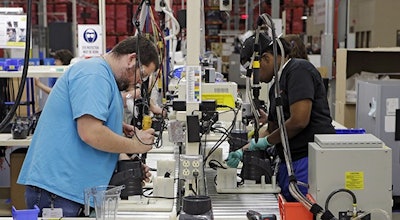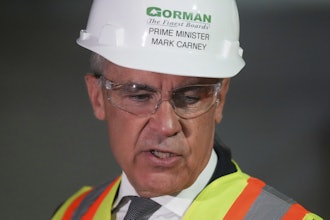
According to the latest Manufacturing ISM Report On Business, May was the 72nd consecutive month for growth in overall economic activity and the 29th consecutive month to see expansion in economic activity in the manufacturing sector. A reading above 50 indicates general expansion, and this month the PMI registered at 52.8 percent.
Bradley J. Holcomb, CPSM, CPSD, chair of the Institute for Supply Management (ISM) Manufacturing Business Survey Committee, said “There are five metrics that add equally into the PMI — new orders, production, employment, supplier delivery and inventories — and they’re all above fifty and pointing in the right direction.”
Of the 18 manufacturing industries, 14 reported growth in May. According to Holcomb, this growth makes sense. “The winter is behind us, the West Coast port issue is behind us, people overseas are getting used to the higher dollar, etc,” said Holcomb. “Spring is in the air and people are in the malls — I was there on Sunday and had a hard time finding a parking space. It is probable that things will go up from this point; we’re well positioned for continued growth as we go forward.”
Orders, Production and Inventory
The New Orders Index registered at 55.8 percent in May, up from April’s 53.5 percent by 2.3 percentage points. This indicates growth in new orders for the 30th consecutive month.
“New orders up 2.3 is always good,” said Holcomb. “It really drives this whole system, ultimately — it’s based on consumers’ confidence.”
The Production Index registered at 54.5 percent in May, which is a decrease of 1.5 percentage points up from April’s 56 percent. The number is still well above 50, which indicates growth.
Production relates to employment and the number of assets that are available. “Last month they took a bit of a downturn in employment just to pause and see which direction things would go, and so a slight decrease makes perfect sense,” Holcomb said. “But the employment numbers this month are very positive, and that bodes well for production in the future.”
The Backlog of Orders Index registered 53.5 percent in May, which was an increase of 4 percentage points from April’s reading of 49.5 percent.
The Inventories Index also saw growth. It registered 51.5 percent in May, which is up two percentage points from 49.5 percentage points in April.
“Inventories these days, through thick and thin and any kind of environment, float up and down a few points around the fifty mark,” said Holcomb. “It all means that inventories are well-balanced and have the right amount of materials to satisfy these new orders and the backlog of orders as well. It’s in a nice range at this time.”
Exports, Imports and Prices
ISM’s Exports Index, which refers to the exporting of finished products, registered at 50 percent in May. Holcomb said, “I’m not at all unhappy with this number, because it is going to take a little longer for the price of the dollar to sink in and for international customers to adjust to it.”
The Imports Index, which refers to the importing of raw materials to feed manufacturing, registered at 55 percent in May, which is 1 percentage point above the 54 percent reported in April. This could be due in part to the price of the dollar overseas.
The ISM Prices Index registered at 49.5 percent in May. This is an increase of 9 percentage points from April’s reading of 40.5 percent, which indicates a decrease in raw materials prices for the seventh consecutive month. May’s prices are still below fifty; this means that they are still decreasing but only by a bit when compared to the past month.
According to Holcomb, the 9 percentage point change is a reflection of how buyers of raw materials are behaving.
“Buyers are holding out and dragging their feet to buy new raw materials, because they are waiting for prices to fall even more or plateau,” said Holcomb. “What they’re now seeing is that we’ve been in the lower price area for several months, and now it is starting to turn back up. The plus nine is a catch-up with respect to the last few months. They feel prices are settling out and now will start to increase.”
Employment
The Employment Index saw an increase of 3.4 percentage points from 48.3 in April to 51.7 in May. Notably, April’s employment was a 1.7 percentage point decrease from the 50 percent reported in March — this reading was the lowest since September 2009.
The increase in the Employment Index is a leading indicator within the manufacturing sector, and Holcomb thinks it is a particularly good sign for manufacturing’s economic activity.
“The high employment index comes off of a month of contraction, which we hadn’t seen in a long time, said Holcomb. “When our manufacturers add to their employment ranks, it generally means that they’re seeing good, strong order books for the next few weeks or months.”
The monthly Manufacturing ISM Report on Business is based on the survey results of approximately 350 professionals across 18 different industry sectors. The report is released on the first business day of each month and features the PMI Index as its key measure. For more information on the Institute of Supply Management, visit www.ism.ws.























